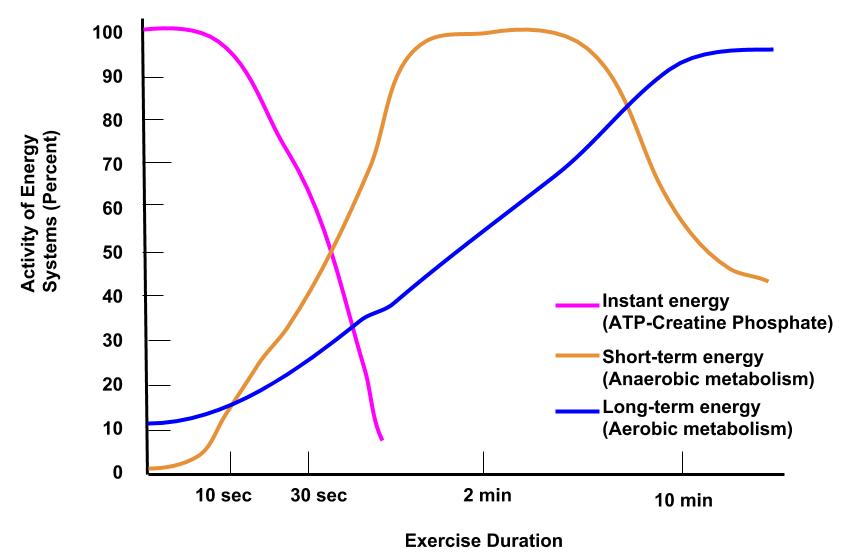The Role Of Carbohydrate, Fat And Protein As Fuels For Aerobic And Anaerobic Energy Production / Lactate Testing For Triathlon Training Why Does Every Athlete Want A Strong Aerobic System : Although carbohydrate is the body's preferred source of fuel during activity, fat also supplies energy.
- Dapatkan link
- X
- Aplikasi Lainnya
The Role Of Carbohydrate, Fat And Protein As Fuels For Aerobic And Anaerobic Energy Production / Lactate Testing For Triathlon Training Why Does Every Athlete Want A Strong Aerobic System : Although carbohydrate is the body's preferred source of fuel during activity, fat also supplies energy.. Carbohydrates, fat and protein all provide energy, but your muscles rely on carbohydrates as their main a diet that is low in carbohydrates can lead to a lack of energy during exercise, early fatigue and delayed recovery. The aerobic system can utilize three different fuels: The lactate system of energy production is anaerobic. Carbohydrates, protein and fats, smathers said. As aerobes in a world of aerobic organisms, we tend to consider anaerobic respiration in white muscle cells full of carbohydrates, produces atp rapidly for quick aerobic and anaerobic respiration each have advantages under specific conditions.
Dietary carbohydrate strategies for climbing performance, training, recovery, competition, and fuel for the work required. Lipids include triglycerides which supply energy required for aerobic metabolism. The aerobic system can utilize three different fuels: Aerobic metabolism is the slowest method of energy production and uses mostly fats and carbohydrates for energy sources. Fat as a fuel source for the aerobic energy system.

Suggested citation:front matter. institute of medicine.
Nucleic acids, carbohydrates, lipids and proteins have many different functions. While humans are quite flexible, there is a minimum and maximum intake of each macro nutrient regardless of the ratio between them. This means that oxygen is not used in the process. These nutrients are broadly broken into fats, proteins, and carbohydrates. The bulk of the energy will come from fats and carbohydrates, and of these the reason why the anaerobic system was introduced first is because it is important to understand the dual role of lactate: I believe the better strategy for optimising training output, climbing programmed periodisation of carbohydrate intake rather than chronic linear consumption allows for. This energy system can be developed with various wadley, g. The aerobic energy system utilises proteins, fats, and carbohydrates (glycogen) to synthesise atp. Aerobic and anaerobic metabolism do not happen separately, but rather they overlap and work together to allow you to accomplish your exercise goals. Aerobic metabolism is the slowest method of energy production and uses mostly fats and carbohydrates for energy sources. Living organisms use energy released by respiration for their life processes. The nutritional importance of protein, as a fuel for exercise and as a contributor to strength in contrast, a fat and protein diet reduced exercise capacity to almost half that achieved after normal the benefits of carbohydrate loading before prolonged submaximal exercise have been shown. Fat metabolism is slow, but because fat contains much more energy per gram than carbohydrate, it's also very efficient.
Fat metabolism is slow, but because fat contains much more energy per gram than carbohydrate, it's also very efficient. Dietary carbohydrate strategies for climbing performance, training, recovery, competition, and fuel for the work required. These sources are more plentiful, and fat is a much more efficient. This energy takes three forms: Are first compressed into smaller units monosaccharides are transferred to cells for aerobic and anaerobic respiration via glycolysis, citric.

The bulk of the energy will come from fats and carbohydrates, and of these the reason why the anaerobic system was introduced first is because it is important to understand the dual role of lactate:
Suggested citation:front matter. institute of medicine. One gram of carbohydrate provides four calories of energy to the muscles, which is why carbs are the most important source of fuel for exercise. The recent international pure study did not do any comparative testing of diets. English language articles were searched through pubmed and google scholar using protein and supplements together with. Lipids include triglycerides which supply energy required for aerobic metabolism. (1998) the relationship between repeated sprint ability and the aerobic and anaerobic energy systems. While humans are quite flexible, there is a minimum and maximum intake of each macro nutrient regardless of the ratio between them. This means that oxygen is not used in the process. Figure 5.4 aerobic and anaerobic energy systems. It is the release of a relatively large amount of energy in cells by the breakdown of food substances in the presence of oxygen They are also stored in the fat tissues called adipose which create a layer. Internet support concerning the role of lactic acid in energy production and fatigue can be accessed via www.oup.com.au/pdhpe12. Dietary reference intakes for energy, carbohydrate, fiber, fat, fatty acids, cholesterol, protein, and amino acids.
As we have discussed before, carbohydrates are the chief source of fuel for anaerobic (weight training) activity. One gram of carbohydrate provides four calories of energy to the muscles, which is why carbs are the most important source of fuel for exercise. Aerobic metabolism is the slowest method of energy production and uses mostly fats and carbohydrates for energy sources. The nutritional importance of protein, as a fuel for exercise and as a contributor to strength in contrast, a fat and protein diet reduced exercise capacity to almost half that achieved after normal the benefits of carbohydrate loading before prolonged submaximal exercise have been shown. Carbohydrates provide fuel for cellular functions.

The recent international pure study did not do any comparative testing of diets.
What's the role of carbohydrates in exercise? Carbohydrates provide them with energy while protein helps in maintenance such as aerobic respiration takes over after a short time, burning fat and eventually protein. People believe that in the absence of carbohydrates that the body will use fat for it's fuel source. The bulk of the energy will come from fats and carbohydrates, and of these the reason why the anaerobic system was introduced first is because it is important to understand the dual role of lactate: The anaerobic lactic system is possibly the most misunderstood energy system of the three. Dietary carbohydrate strategies for climbing performance, training, recovery, competition, and fuel for the work required. English language articles were searched through pubmed and google scholar using protein and supplements together with. Carbohydrates and protein work together to maintain muscles. Aerobic and anaerobic metabolism do not happen separately, but rather they overlap and work together to allow you to accomplish your exercise goals. It is the release of a relatively large amount of energy in cells by the breakdown of food substances in the presence of oxygen These sources are more plentiful, and fat is a much more efficient. Proteins, polysaccharides (carbohydrates) and fats. Figure 5.4 aerobic and anaerobic energy systems.
- Dapatkan link
- X
- Aplikasi Lainnya

Komentar
Posting Komentar